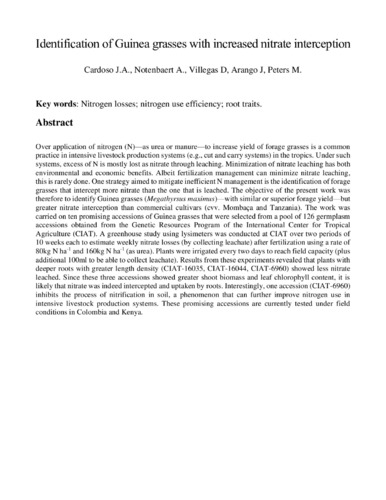Identification of Guinea grasses with increased nitrate interception
Over application of nitrogen (N)—as urea or manure—to increase yield of forage grasses is a common practice in intensive livestock production systems (e.g., cut and carry systems) in the tropics. Under such systems, excess of N is mostly lost as nitrate through leaching. Minimization of nitrate leaching has both environmental and economic benefits. Albeit fertilization management can minimize nitrate leaching, this is rarely done. One strategy aimed to mitigate inefficient N management is the identification of forage grasses that intercept more nitrate than the one that is leached. The objective of the present work was therefore to identify Guinea grasses (Megathyrsus maximus)—with similar or superior forage yield—but greater nitrate interception than commercial cultivars (cvv. Mombaça and Tanzania). The work was carried on ten promising accessions of Guinea grasses that were selected from a pool of 126 germplasm accessions obtained from the Genetic Resources Program of the International Center for Tropical Agriculture (CIAT). A greenhouse study using lysimeters was conducted at CIAT over two periods of 10 weeks each to estimate weekly nitrate losses (by collecting leachate) after fertilization using a rate of 80kg N ha-1 and 160kg N ha-1 (as urea). Plants were irrigated every two days to reach field capacity (plus additional 100ml to be able to collect leachate). Results from these experiments revealed that plants with deeper roots with greater length density (CIAT-16035, CIAT-16044, CIAT-6960) showed less nitrate leached. Since these three accessions showed greater shoot biomass and leaf chlorophyll content, it is likely that nitrate was indeed intercepted and uptaken by roots. Interestingly, one accession (CIAT-6960) inhibits the process of nitrification in soil, a phenomenon that can further improve nitrogen use in intensive livestock production systems. These promising accessions are currently tested under field conditions in Colombia and Kenya.

